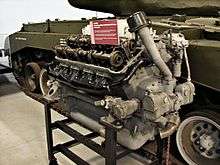Ford GAA engine
| Ford GAA | |
|---|---|
|
| |
| Overview | |
| Manufacturer | Ford Motor Company |
| Production | 1940 - 1950 |
| Layout | |
| Configuration | 60° V8 |
| Displacement | 1,100 cu in (18 L) |
| Cylinder bore | 5.4 in (137 mm) |
| Piston stroke | 6.0 in (152 mm) |
| Valvetrain | DOHC |
| Compression ratio | 7.5:1 |
| Combustion | |
| Fuel system | Naturally aspirated with Stromberg NA-Y5-G carburetors[1] |
| Fuel type | Gasoline |
| Output | |
| Power output | 500 hp (373 kW) @ 2,600 rpm |
The Ford GAA engine is an American all-aluminum 32-valve DOHC 60-degree V8 engine engineered and produced by the Ford Motor Company just before, and during, World War II. It featured twin Stromberg NA-Y5-G carburetors,[2] dual magnetos and twin spark plugs making up a full dual ignition system,[2] and crossflow induction.[3] It displaces 1,100 cu in (18 l) and puts out well over 1,000 pound-feet (1,400 N⋅m) of torque from idle to 2,200 rpm. The factory-rated output was 500 hp (370 kW) at 2,600 rpm.
The GAA was one of the largest displacement mass-produced gasoline V8 engines used in land vehicles.[lower-roman 1] It powered several models and derivatives of the M4A3 medium tank.
Development
Immediately preceding World War II, Ford developed an aircraft engine similar to that of the American Allison engines of that era. It was a 60 degree V-12 of 1,650 cubic inch displacement with a matching set of cylinder bore/piston stroke figures to the Rolls-Royce Merlin aviation engine, using an aluminum block and head; dual overhead camshafts, and four valves per cylinder. The intention of this design was to help Ford break into the anticipated large market for fighter engines. This engine was built to typical aircraft standards: it was light, high performance, and highly reliable. Everything was safety wired or staked with close attention to detail on every part. Available information suggests this design performed well.
However, it never went into production as an aircraft engine due to the United States Navy's decision to only use radial engines for its aircraft, and the Army's contractual commitments to existing manufacturers.
With the approach of war, increasing orders for the M4 tanks were causing supply issues with the Wright R-975 engine used. The U.S. Army decided they needed to source an additional engine supplier, choosing the Ford GAA (now cut down from 12 cylinders to 8) for various applications.
Production

- The GAA was used in the M4A3 (1,690), M4A3(75)W (3,071), M4A3(76)W (1,400), M4A3 (105) (500), M4A3E2 (254), M4A3(76)W HVSS (3,142), M4A3(105) HVSS (2,539), M10A1 (1,413), and M7B1 (826).
- The GAF powered the M26 (2,222), M26A1,T28/T95 Super Heavy Tank (2), and M45 (185).
- The GAN powered the T23 (248) and M4A3E2 (254).
- In order to meet the need for a larger engine, Ford resurrected the V-12 as the GAC, which produced 770 hp (570 kW) and powered the T29 (6).
- A number of M74 tank recovery vehicles were rebuilt from M4A3s, which used the GAA.[4]
See also
Notes
- ↑ The Rolls-Royce Meteorite was another of almost identical capacity
References
- Berndt, Thomas. Standard Catalog of U.S. Military Vehicles. Iola, WI: Krause Publications, 1993. ISBN 0-87341-223-0.
- Sprowl, Bob. Ford's First Dual Over Head Cam V-8.
- Aircraft Engine Historical Society.Aircraft Engines in Armored Vehicles
- Hunnicutt, R. P. Firepower: A History of the American Heavy Tank. Novato, California: Presidio Press, 1988. ISBN 0-89141-304-9
External links
- https://www.youtube.com/watch?v=W2ghTjFtNPo engine running
- "1,500 H.P. Ford V-12" a 1941 Flight article on the Ford V-12 aero engine the GAA was based on
- "The Ford Aero Engine" a 1941 Flight article